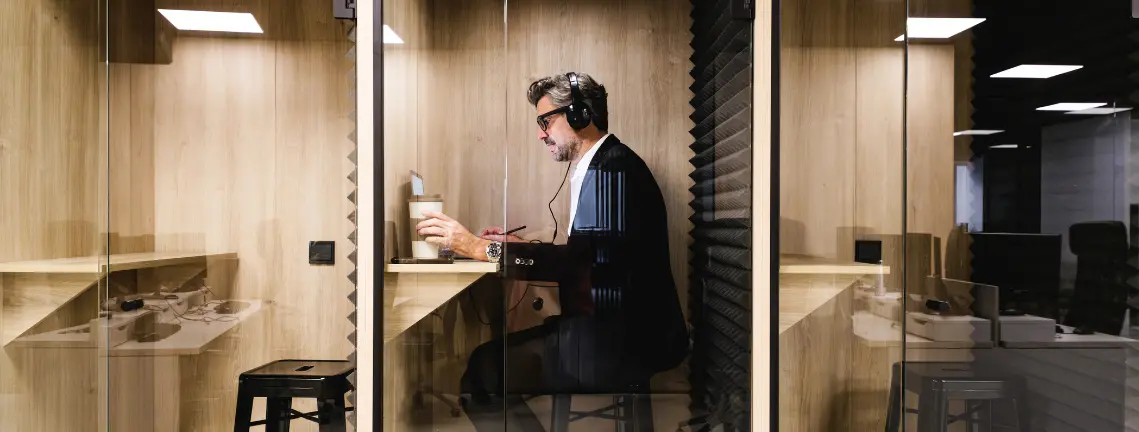Bright Ideas for Eye-Friendly Home Office Lighting


Working from home has become the norm for many professionals. The home office has transformed into an essential space where creativity, productivity, and innovation thrive. However, this space can quickly become a source of eye strain and discomfort without proper home office lighting. Researchers have documented consistent effects concerning the impact of lighting on visual performance and health that have led to decreased focus and productivity in the home office.
Natural light and outdoor views have become a priority for desk-based professionals, according to “The Employee Experience” by Future Workplace. Their survey found that natural light and views of the outdoors are the preferred attributes of the workplace environment, outranking longstanding favourites like onsite canteens, fitness centres, and premium perks, including on-site childcare. Furthermore, the benefits of natural light in the workplace are astounding for office productivity.
In this blog, we will explore a myriad of bright home office lighting ideas to create an eye-friendly home office with the perfect lighting setup. These ideas will not only help protect your eyes but also enhance your overall work experience.
Understanding the Importance of Eye-Friendly Lighting
Before delving into the various lighting options, it is crucial to understand why eye-friendly lighting is vital. The eyes are susceptible to light, and prolonged exposure to harsh lighting can lead to eye fatigue, dryness, and headaches and affect a person’s overall mood. Poor lighting can also cause glare and shadows, making it difficult to focus on tasks. Consider factors such as colour temperature, brightness, and positioning to optimise your home office lighting.
Embrace Natural Light
Your office design and where you position your office desk can significantly impact your productivity. Regarding office lighting, the most eye-friendly and cost-effective illumination source is natural light. Position your desk near a window to take advantage of natural daylight. However, be cautious of direct sunlight, as it can cause glare on screens. Install sheer curtains or blinds to control the amount of light entering the room.

Invest in Adjustable Task Lighting
Supplement natural light with adjustable task lighting. Office desk lamps with flexible arms and adjustable brightness settings allow you to customise the lighting to suit your needs. Look for office lamps with warm or neutral colour temperatures (3000K-4000K) as they are easier on the eyes than cool white lights.
Consider LED Lighting
LED bulbs are energy-efficient and have a longer lifespan than traditional incandescent bulbs. Additionally, they emit less heat, reducing the risk of discomfort during long working hours. Opt for LED bulbs with a high CRI (Colour Rendering Index) to ensure accurate colour representation.
Implement Indirect Lighting
Direct lighting can create harsh shadows and glare. Consider incorporating indirect lighting by using wall sconces or uplighting fixtures. Indirect lighting bounces light off walls and ceilings, creating a softer, more diffused glow that reduces eye strain.
Dimmers and Smart Lighting
Install dimmer switches or invest in intelligent lighting systems that allow you to adjust the brightness according to your needs. Dimmed lights can create a cosy atmosphere during late-night work sessions, reducing eye strain.
Task-Based Lighting Zones
Create task-based lighting zones within your home office. For example, use brighter lighting around your desk area for focused work tasks and slightly dimmer lighting in the reading nook for relaxing breaks. This zoning helps provide the right amount of light for different activities, reducing eye strain.

Blue Light Filtering
Increasing numbers of office workers report impacted eye health due to prolonged use of digital devices. Blue light emitted from electronic devices mainly results in many suffering from digital eye strain.
Consider using blue light filters on your computer screens and invest in blue light-blocking glasses to protect your eyes from prolonged exposure.
Reduce Glare and Reflections
Position your computer screen perpendicular to the windows to reduce glare. Use an anti-glare screen filter to minimise reflection if needed. Additionally, place reflective objects like mirrors away from your direct line of sight to minimise distracting reflections.
Balanced Ambient Lighting
Achieve a balanced home office ambient lighting setup that evenly distributes light throughout the room. This ensures that there are no stark contrasts between bright and dark areas, reducing eye strain caused by rapid adjustments in lighting levels.
Light Colour and Psychological Impact
The colour of light can also influence your mood and productivity. Cooler tones are more energising and suitable for focused work, while warmer tones promote relaxation and creativity. Consider using colour-changing smart bulbs to set the right ambience for various tasks.
Regular Eye Breaks
Regular eye breaks are essential regardless of how well you optimise your home office lighting. Follow the 20-20-20 rule: Every 20 minutes, take a 20-second break and look at something 20 feet away to rest your eyes.

Creating an eye-friendly home office is an investment in your well-being and productivity. By implementing these bright ideas for eye-friendly lighting, you can ensure that your workspace supports your work and creativity while safeguarding your precious eyesight. Remember to balance natural, task, and ambient lighting to create a harmonious and comfortable environment that enables you to thrive in your work-from-home journey. Your eyes will thank you, and you will feel more inspired and energised as you tackle your daily tasks with clarity and ease.
If you need to source the right ergonomic equipment for your employees, Codex can help. In addition to the ergonomic assessments, we offer all types of ergonomic desks, chairs and accessories to help keep your employees safe and productive. Contact us today to learn more about workplace ergonomics.
RELATED ARTICLES:



